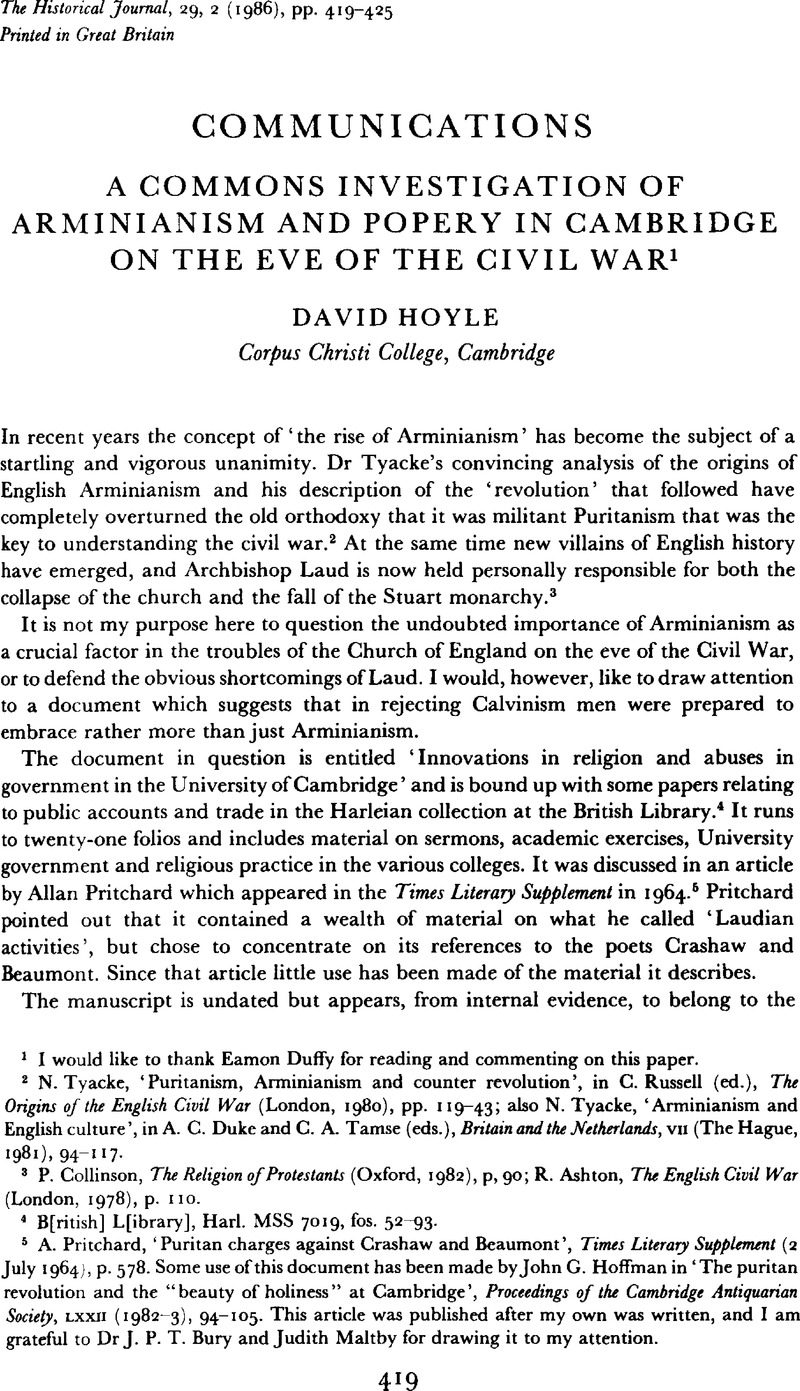Article contents
A Commons Investigation of Arminianism and Popery in Cambridge on the Eve Of the Civil War1
Published online by Cambridge University Press: 11 February 2009
Abstract

- Type
- Communications
- Information
- Copyright
- Copyright © Cambridge University Press 1986
References
2 Tyacke, N., ‘Puritanism, Arminianism and counter revolution’, in Russell, C. (ed.), The Origins of the English Civil War (London, 1980), pp. 119–43Google Scholar; also Tyacke, N., ‘Arminianism and English culture’, in Duke, A. C. and Tamse, C. A. (eds.), Britain and the Netherlands, VII (The Hague, 1981), 94–117CrossRefGoogle Scholar.
3 Collinson, P., The Religion of Protestants (Oxford, 1982), p, 90Google Scholar; Ashton, R., The English Civil War (London, 1978), p. 110Google Scholar.
4 B[ritish] L[ibrary], Harl. MSS 7019, fos. 52–93.
5 Pritchard, A., ‘Puritan charges against Crashaw and Beaumont’,Times Literary Supplement (2 07 1964), p. 578Google Scholar. Some use of this document has been made by Hoffman, John G. in ‘The puritan revolution and the “beauty of holiness” at Cambridge’, Proceedings of the Cambridge Antiquarian Society, LXXII (1982–3), 94–105Google Scholar. This article was published after my own was written, and I am grateful to Dr J. P. T. Bury and Judith Maltby for drawing it to my attention.
6 See references to Cosin and concern that he is about to charge the university expenses for his year in office. Harl. MSS 7019, fo. 69.
7 Pritchard, ‘Puritan charges’.
8 Commons journals, I 930.
9 Commons journals, II p. 126.
10 C[ambridge] U[niversity] A[rchives], CUR 20.1, no. 621.
11 Ibid. 622.
12 Heywood, J., Collection of Statutes for the University and Colleges (London, 1840), appendix, Statutes of Queen Elizabeth, p. 29Google Scholar.
13 B.L., Harl. MSS 7019, fo. 53.
14 Ibid.
15 Gardiner, S. R., The constitutional documents of the Puritan revolution (Oxford, 1899), pp. 75–6Google Scholar.
16 I.e. Love of Corpus, Ward of Sidney, Sibbes of St Catharine's, Bainbrigg of Christ's, Batchcroft of Caius and Sandcroft of Emmanuel. Brownrigg and Holdsworth, who succeeded Sibbes and Sandcroft, were equally loyal members of this party. Against them were ranged Wren and his successor at Peterhouse, Cosin, Laney of Pembroke, Martin of Queens’, Sterne of Jesus and Beale of St John's. Eden of Trinity Hall and Collins of King's tended to vote with the same group. Comber of Trinity, Paske of Clare and Smyth of Magdalene cannot be placed in either group.
17 Letter from Ward to Ussher; Ussher, J., The Whole Works, –ed. Ellington, C. R. (Dublin, 1847–1964), xv, 580Google Scholar. Commencement day was one of the major events in the university calendar, a public occasion when doctors and masters of arts received their degrees. It provided an important platform for those involved in the day's academic exercises.
18 P[ublic] R[ecord] O[ffice], S.P. (Dom.) 16/437/25, 46 ff. Ussher, Works, xv, 580 ff.
19 B.L., Harl. MSS 7019, fo. 54.
20 Martin, , letter to Bray, , Cambridge Antiquarian Society Communications, II (1860–4), 149–59Google Scholar.
21 B.L., Harl. MSS 7019, fos. 55–6.
22 Ibid. fos. 57–60. A fuller account can be found in the Act books of the vice-chancellor's court, CUA VC CT I 56, fos. 131 ff.; I 57, fos. 57 ff.
23 Sparrow, A., Confession of sins and the power of absolution in a sermon (London, 1704)Google Scholar.
24 Collier, J., An ecclesiastical history (London, 1852), p. 120Google Scholar.
26 Cooper, C. H., Annals of Cambridge (Cambridge, 1845), III, 288Google Scholar.
26 Heywood, , Collection of Statutes, appendix, p. 29Google Scholar.
27 Waterworth, J., Canons and decrees of the Council of Trent (London, 1888), pp. 23, 24Google Scholar.
28 See the first exhortation at the Communion Service and the rubrics of the Order for the Visitation of the Sick.
29 CUA VC CT I 57, fos. 104 B ff.
30 B.L., Harl. MSS 7019, fo. 61; see also CUA, CUR 18 no. 610.
31 White, P., ‘The rise of Arminianism reconsidered’, Past and Present, CI, 34–54Google Scholar, recently argued that there were ‘theological tensions’ within the Elizabethan church and that the situation was more complex than a general agreement on doctrinal Calvinism would allow. Whilst I do not agree with all that Mr White says, he has clearly shown that those ‘tensions’ gave men with very different views room for manoeuvre.
32 B.L., Harl. MSS 7019, fo. 63.
33 See the entries on Nathaniel Bernar and Thomas Riley, B.L., Harl. MSS 7019, fos. 91–3.
34 Ibid. pp. 86–9.
35 Ibid. pp. 65–7.
36 Ibid. p. 65.
37 Ibid.
38 Ibid. p. 64.
39 Commons Journals, 11, 18; Nalson, J., An impartial collection of the great affairs of state, 1 (1682), 709 ffGoogle Scholar.
40 B.L., Harl. MSS 7019, fos. 68–70.
41 Ibid. fos. 71 ff.
42 Tyacke, , ‘Arminianism in England’, p. 129Google Scholar; idem, ‘Arminianism in English culture’, p. 104.
43 Commons Journals, 1, 932, Root and Branch Petition quoted by Kenyon, J. P, Stuart constitution (Cambridge, 1966), p. 173Google Scholar.
44 Prefatory verse to Shelford, R., Five pious and learned discourses (Cambridge, 1635)Google Scholarsig. Av.
- 4
- Cited by


